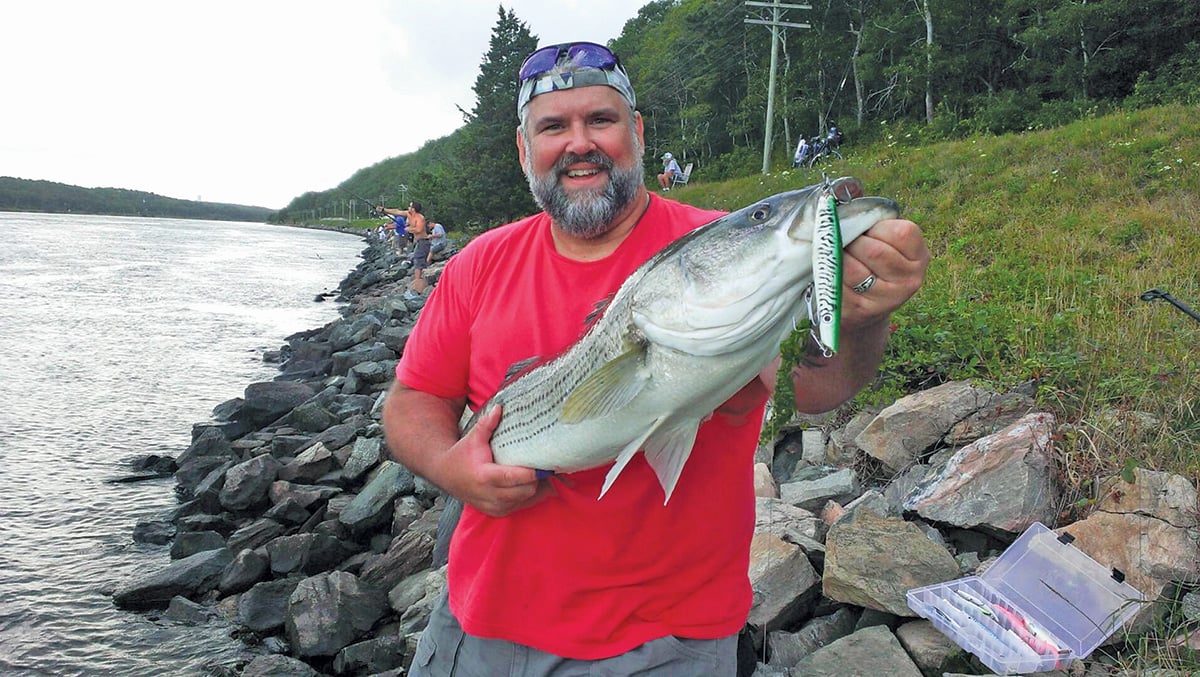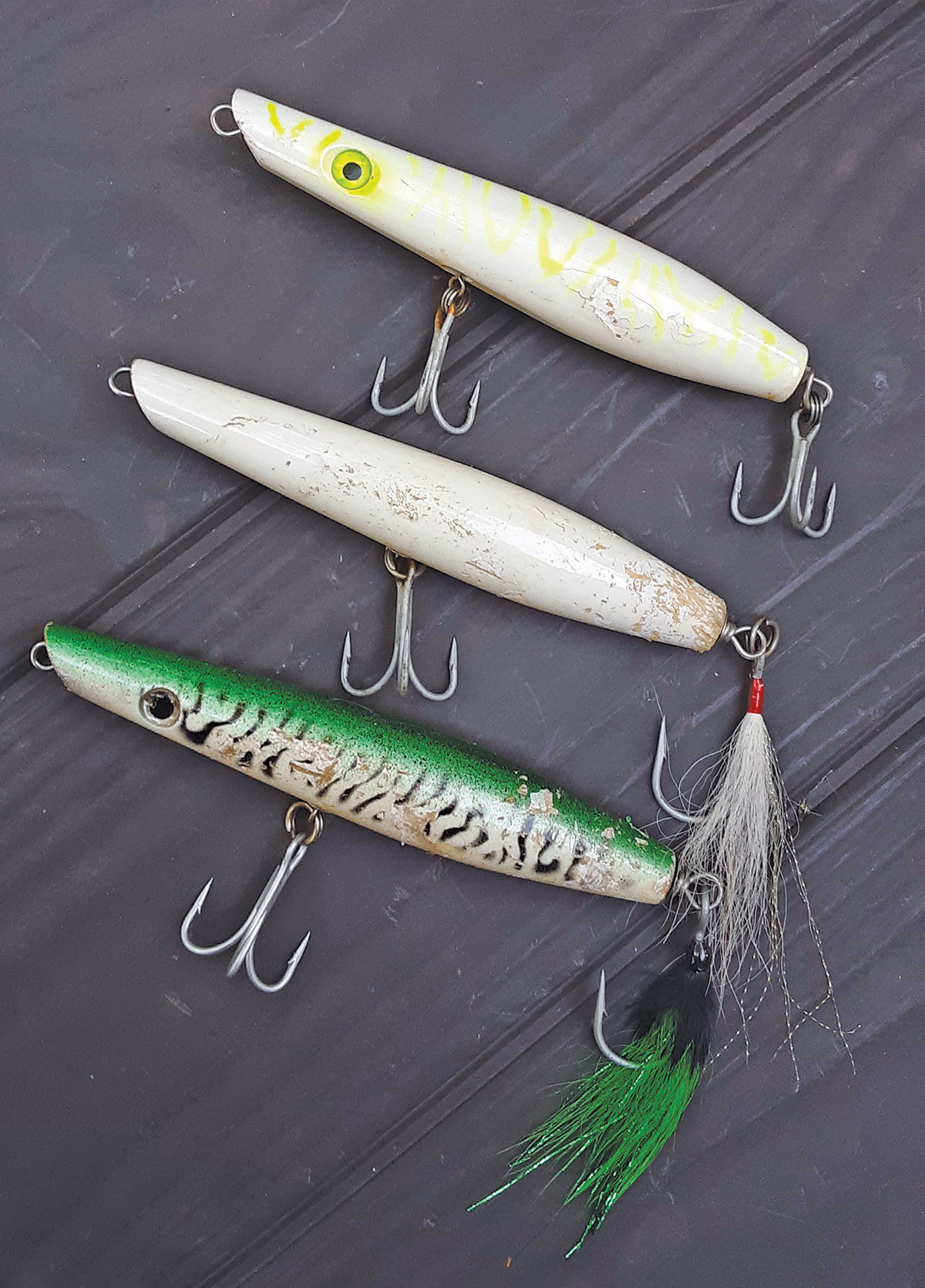
Many tides ago, before the bass returned en masse to the Cape Cod Canal, I heard from old timers of a technique where pencil poppers—such as those made by Cotton Cordell—were drilled out and loaded with BBs to add extra weight. I had also seen this described in various forms featuring tips from local sharpies. But, as it where, those days also saw fine fishing from the beaches on the Cape, so most of my ventures saw me trekking the sand in search of bass and blues. However, as the days passed, and fishing conditions changed in certain areas for a variety of reasons, so did my focus. Where the Canal used to be just a, “I’ll quickly check it out when I cross the bridge,” spot for me, it now makes my short list of primary stops. It was there that I first started to employ that technique I had seen long ago, jigging a pencil popper, with great success.
At first glance, loading a plastic pencil popper appears to be destined for one thing: distance. I’m sure for some that is the exact and only reason they are doing it, to reach those fish far offshore and way out past the middle of wide spaces like the Canal. However, I soon realized after spending some quality outings on the rocks of the ditch, that some sharpies were actually “jigging” their loaded pencils and other heavily-lead-laden sinking wooden versions. But not only were they jigging, they were catching!
It quickly becomes obvious why this technique works so well, as the end result appears to be an injured mackerel, or other large baitfish, twitching frantically in the current. The Canal—any deep-water location, really—is the perfect spot to try this technique, and I have firsthand accounts of successful hookups from Sandwich to Boston Harbor. I’m confident you could even put this technique to use offshore when school tuna are gathered. I can only imagine the crushing hit a 60-pound bluefin would deliver when it sees a fluttering mackerel pencil dance above one of the Stellwagen shallow humps!
Obviously, if you’re giving it a go with a loaded pencil, you can dictate how heavy and how deep you hope to achieve. If the bottom of the Canal is your quest, for example, then you’ll want to really load up the lead similar to some of the heavy jigs of today that are popular when fishing during the stronger currents. However, you don’t need to bury 6 ounces of lead in a plastic pencil for this method to be effective. Heavy, tail-weighted wooden pencils from 2 to 4 ounces such as those made by Left Hook, Guppy, BigFish Bait Co. and other custom builders can be just as effective during slower tide periods or by casting up-current and fishing mid-depth.
Granted the last couple of years have seen stellar fishing in the Canal when fish were quite visible at times, but the reality is that there can be times when the fish just aren’t showing, but they are there, proved by the dedicated jig fishermen and their results. However, rather than dragging lead over the rough bottom, this technique allows you to fish a variety of depths and quickly switch to topwater when needed without swapping out plugs. This exact scenario played out just a few years back under a bright, late-August sun.
I pulled into the gas station, filling up to head to one of my southward albie spots, when a fellow surfcaster saw the rods on my truck. Exchanging a few pleasantries, he was kind enough to tell me that he had been into the bass over the last couple of days, catching the midday west tide. The albies weren’t quite in that heavy yet so it was an easy decision to quickly stop back home and grab my Canal gear. Not long after I pulled into the Herring Run parking lot, eager to get to my destination a short trek down the fire road. Approaching one of the well-known rips, I was surprised to see that it wasn’t elbow to elbow, and the reports from fellow anglers revealed why. The morning’s tide hadn’t produced much if any bites, and a lot of the early crew had enough. Those who remained, however, also appeared in on the reports that the tide turning west had the bass chasing the bait down the shoreline; I figured it wouldn’t be long before they made an appearance.
It took about an hour for the bass to arrive, as a gentleman to my left hooked just about the time the fish showed on top right in front of me. I launched my pencil popper towards the edge of the action, watching as the heavy, custom mackerel plug did the dance, only to be crushed by a nice 20-pound bass. Another striper in the same class was soon to follow. The topwater bite was brief as the fish continued westward, and shortly thereafter a good majority of the Canal crew followed suit, exiting to the parking lot to pursue other vices. I wasn’t so quick to throw in the towel as I knew there had to be some fish still foraging, but perhaps down deep. It was time to do the pencil popping jig.

Spying the rip, I cast my pencil far to my left, towards the middle of the Canal, and let it sink and drift in the current until it was almost perpendicular to my position. The flow was moving at a moderate pace, and I felt but one tic of a rock before losing contact with the bottom. My targeted range was the bottom to mid-depth. I repeated this pattern several times, slightly altering my cast touching down closer and further out; and just prior to making a shoreline move my plug was hammered by a nice fish. A dogged battle in the current followed, finally resulting in a beautiful bass just shy of the 30-pound mark.
A short time after I capped off the tide, and this excursion, with a repeat performance, but that time I was in for a rocky footrace. The hit was not as noticeable as the previous bite, but regardless, my drag was screaming in the current. Not one to throw a monkey wrench in other surfcaster’s plans, this time I was stumbling over the shoreline going over and under a couple of guys to my right. While offering words of confidence, I knew they couldn’t be too happy about me interrupting their outing, especially when my fish came to shore. Disheartened to say the least, my giant bass had morphed into a 37-inch fish that had been snagged in the tail, a victim of the old “swing and a miss.”
Not to be swayed by the snagging mishap, in the years that followed the pencil popper jigging technique has produced many a hook-up, and it is put into action during every trip where deep water and bass coexist. One more tip that I can offer is to keep your line tight as the pencil drifts deep in the current, work it like you are “walking the dog” with short snaps, and hold on tight!




